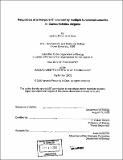| dc.contributor.advisor | H. Robert Horvitz. | en_US |
| dc.contributor.author | Perez de la Cruz, Ignacio, 1973- | en_US |
| dc.contributor.other | Massachusetts Institute of Technology. Dept. of Biology. | en_US |
| dc.date.accessioned | 2006-03-24T18:02:04Z | |
| dc.date.available | 2006-03-24T18:02:04Z | |
| dc.date.copyright | 2002 | en_US |
| dc.date.issued | 2002 | en_US |
| dc.identifier.uri | http://hdl.handle.net/1721.1/29908 | |
| dc.description | Thesis (Ph.D.)--Massachusetts Institute of Technology, Dept. of Biology, 2002. | en_US |
| dc.description | Includes bibliographical references. | en_US |
| dc.description.abstract | K+ channels generate and tune the electrical signals that underlie the functioning of neurons and other excitable cells. We have studied a set of genetically-interacting genes, sup-9, sup-10 and unc-93, whose products are predicted to form a protein complex that when misregulated leads to severe muscle paralysis in the nematode C. elegans. We cloned sup-9 and found it encodes a K+ channel of the recently discovered mammalian two-pore family of voltage-insensitive leak channels, suggesting that SUP-10 and UNC-93, along with multiple UNC-93-like genes in Drosophila and humans, are the first regulatory subunits for two-pore K+ channels. Based on pharmacological data, we propose that gain-of-function mutations in the sup-9 channelor in its proposed subunits result in muscle paralysis through excessive K+ efflux and hyperpolarization of muscle cells. We cloned sup-18, a regulator of the channel complex, and show that SUP-18 is a type-three transmembrane protein that colocalizes with SUP-9 in muscle membranes and whose intracellular domain is similar to bacterial NADH nitroreductases that use an FMN cofactor. We identified a mutation in a predicted FMN-binding residue of SUP-18 that both eliminates its in vivo function without disrupting its membrane localization and that impairs the enzymatic activity of a related Thermophilus enzyme, suggesting that SUP-18 may couple cell metabolism with membrane excitability. | en_US |
| dc.description.abstract | (cont.) Through genetic and molecular studies, we determined that the SUP-10 subunit acts together with SUP-18 to activate the SUP-9 channel through a novel conserved domain in SUP-9. This domain is not required for the activation of SUP-9 by UNC-93, thus defining two independent modes of activation for a two-pore channel by multiple subunits. We also discovered a second domain in SUP-9, conserved in the human TASK-1 and TASK-3 channels, that integrates multiple regulatory inputs. Finally, our analysis of the subcellular localization of other C. elegans two-pore channels suggests that they can be differentially targeted within the cell membrane of muscle cells. | en_US |
| dc.description.statementofresponsibility | by Ignacio Perez de la Cruz. | en_US |
| dc.format.extent | 234 leaves | en_US |
| dc.format.extent | 10184954 bytes | |
| dc.format.extent | 10183807 bytes | |
| dc.format.mimetype | application/pdf | |
| dc.format.mimetype | application/pdf | |
| dc.language.iso | eng | en_US |
| dc.publisher | Massachusetts Institute of Technology | en_US |
| dc.rights | M.I.T. theses are protected by copyright. They may be viewed from this source for any purpose, but reproduction or distribution in any format is prohibited without written permission. See provided URL for inquiries about permission. | en_US |
| dc.rights.uri | http://dspace.mit.edu/handle/1721.1/7582 | |
| dc.subject | Biology. | en_US |
| dc.title | Regulation of a two-pore K+ channel by multiple subunits in Caenorhabditis elegans | en_US |
| dc.type | Thesis | en_US |
| dc.description.degree | Ph.D. | en_US |
| dc.contributor.department | Massachusetts Institute of Technology. Department of Biology | |
| dc.identifier.oclc | 51640229 | en_US |
